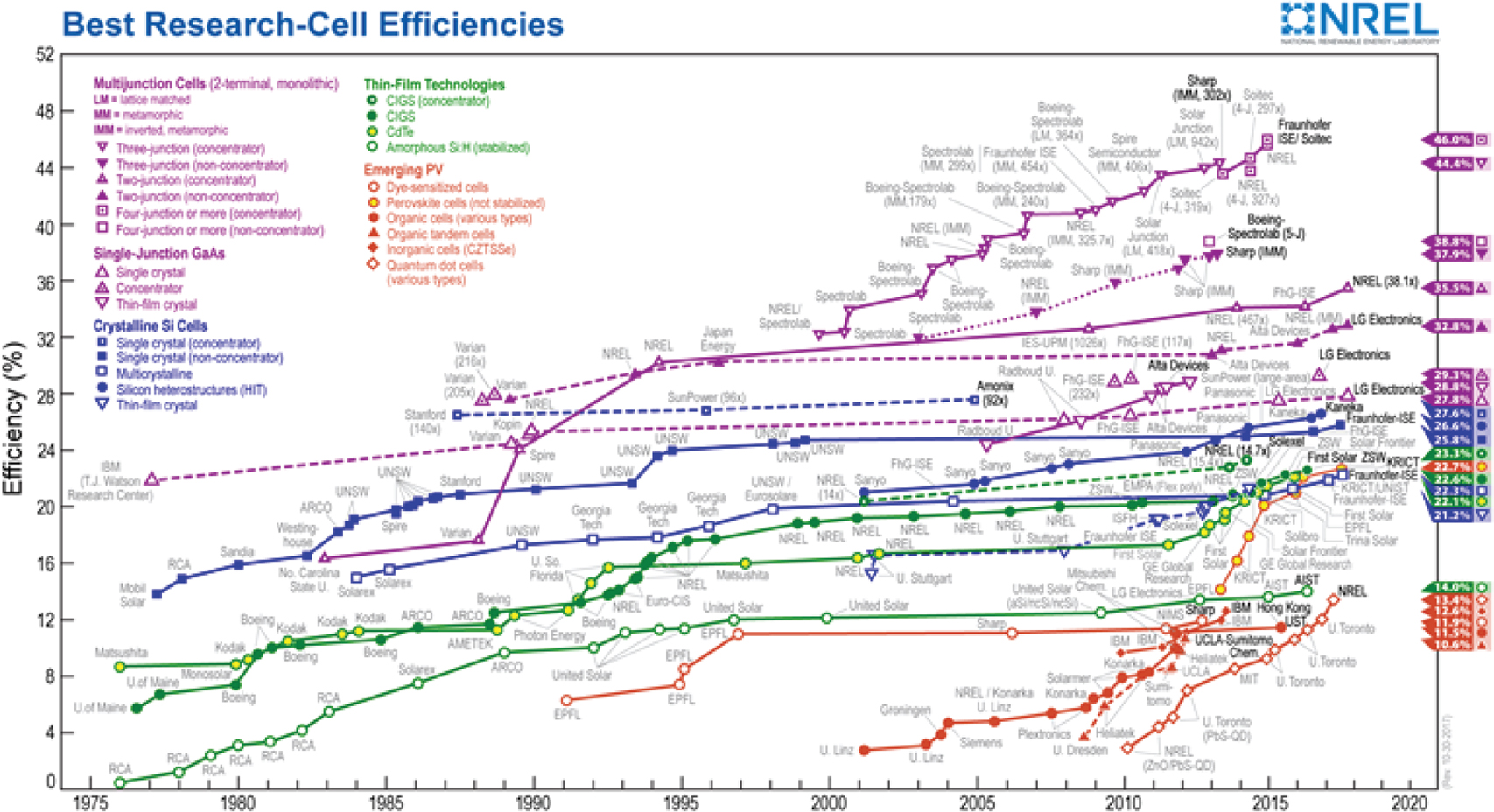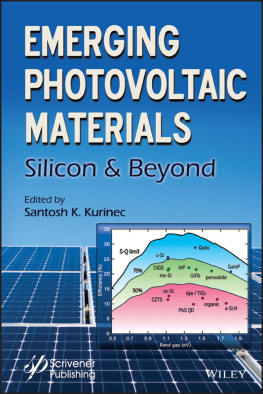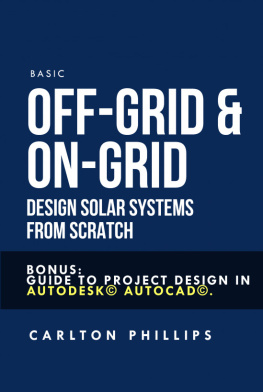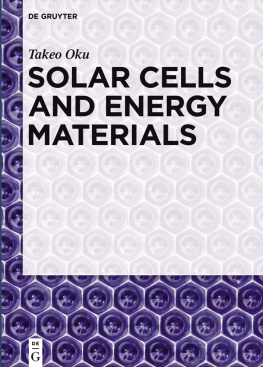Kurinec Santosh K. - Emerging Photovoltaic Materials
Here you can read online Kurinec Santosh K. - Emerging Photovoltaic Materials full text of the book (entire story) in english for free. Download pdf and epub, get meaning, cover and reviews about this ebook. year: 2018, publisher: John Wiley & Sons, Inc., genre: Children. Description of the work, (preface) as well as reviews are available. Best literature library LitArk.com created for fans of good reading and offers a wide selection of genres:
Romance novel
Science fiction
Adventure
Detective
Science
History
Home and family
Prose
Art
Politics
Computer
Non-fiction
Religion
Business
Children
Humor
Choose a favorite category and find really read worthwhile books. Enjoy immersion in the world of imagination, feel the emotions of the characters or learn something new for yourself, make an fascinating discovery.
- Book:Emerging Photovoltaic Materials
- Author:
- Publisher:John Wiley & Sons, Inc.
- Genre:
- Year:2018
- Rating:5 / 5
- Favourites:Add to favourites
- Your mark:
- 100
- 1
- 2
- 3
- 4
- 5
Emerging Photovoltaic Materials: summary, description and annotation
We offer to read an annotation, description, summary or preface (depends on what the author of the book "Emerging Photovoltaic Materials" wrote himself). If you haven't found the necessary information about the book — write in the comments, we will try to find it.
Emerging Photovoltaic Materials — read online for free the complete book (whole text) full work
Below is the text of the book, divided by pages. System saving the place of the last page read, allows you to conveniently read the book "Emerging Photovoltaic Materials" online for free, without having to search again every time where you left off. Put a bookmark, and you can go to the page where you finished reading at any time.
Font size:
Interval:
Bookmark:

- Preface
- Chapter 1
- Chapter 2
- Chapter 3
- Chapter 4
- Chapter 5
- Chapter 6
- Chapter 7
- Chapter 8
- Chapter 9
- Chapter 10
- Chapter 11
- Chapter 12
- Chapter 13
- Chapter 14
- Chapter 15
- Chapter 16
- Chapter 17
- Chapter 18
- Chapter 19
- Chapter 1
- Chapter 2
- Chapter 3
- Chapter 4
- Chapter 5
- Chapter 6
- Chapter 8
- Chapter 9
- Chapter 10
- Chapter 12
- Chapter 15
- Chapter 17
- Chapter 18
- Chapter 19
Scrivener Publishing
100 Cummings Center, Suite 541J
Beverly, MA 01915
Publishers at Scrivener
Martin Scrivener ()
Phillip Carmical ()
Managing Editors: George Mishra and Sophie Thompson
Edited by
Santosh K. Kurinec
Rochester Institute of Technology, NY, USA

This edition first published 2018 by John Wiley & Sons, Inc., 111 River Street, Hoboken, NJ 07030, USA and Scrivener Publishing LLC, 100 Cummings Center, Suite 541J, Beverly, MA 01915, USA
2019 Scrivener Publishing LLC
For more information about Scrivener publications please visit www.scrivenerpublishing.com.
All rights reserved. No part of this publication may be reproduced, stored in a retrieval system, or transmitted, in any form or by any means, electronic, mechanical, photocopying, recording, or otherwise, except as permitted by law. Advice on how to obtain permission to reuse material from this title is available at http://www.wiley.com/go/permissions.
Wiley Global Headquarters
111 River Street, Hoboken, NJ 07030, USA
For details of our global editorial offices, customer services, and more information about Wiley products visit us at www.wiley.com.
Limit of Liability/Disclaimer of Warranty
While the publisher and authors have used their best efforts in preparing this work, they make no representations or warranties with respect to the accuracy or completeness of the contents of this work and specifically disclaim all warranties, including without limitation any implied warranties of merchantability or fitness for a particular purpose. No warranty may be created or extended by sales representatives, written sales materials, or promotional statements for this work. The fact that an organization, website, or product is referred to in this work as a citation and/or potential source of further information does not mean that the publisher and authors endorse the information or services the organization, website, or product may provide or recommendations it may make. This work is sold with the understanding that the publisher is not engaged in rendering professional services. The advice and strategies contained herein may not be suitable for your situation. You should consult with a specialist where appropriate. Neither the publisher nor authors shall be liable for any loss of profit or any other commercial damages, including but not limited to special, incidental, consequential, or other damages. Further, readers should be aware that websites listed in this work may have changed or disappeared between when this work was written and when it is read.
Library of Congress Cataloging-in-Publication Data
ISBN 978-1-119-40754-6
The global solar market grew by 26% in 2017. According to research, the installed grid-connected photovoltaics (PV) capacity is approaching 100 gigawatts (Source: GTM Research Data Hub). The cost of solar power has declined at a rate of approximately 12% annually over the last five years. Such cost reductions are driven by continuous technological developments in achieving higher solar PV module efficiencies with improved manufacturing processes. To keep up with the increasing demand and achieve high energy return on energy invested (EROI), it is necessary for researchers to strive for lower costs, higher efficiencies and longer lifetime of PV technologies.
Semiconductors are materials that generate free carriers (such as Si and GaAs) or excitons (in organics, which are dissociated to form free carriers) when exposed to photons with energies exceeding their optical bandgaps. These excess carriers are swept via a built-in electric field in the device and extracted at the contacts, which can drive a load and provide useful power output. Photovoltaic (PV) devices and modules made from crystalline silicon currently dominate the market. In the continued quest for lowering the cost, many efforts are being pursued that involve the use of alternative materials. Over the years, the development of PV technology has undergone numerous changes, which has led to cells being classified into different generations, originally defined for inorganic materials as high cost/high efficiency (1st generation), low cost/low efficiency (2nd generation) and low cost/high efficiency (3rd generation).
The U.S. National Renewable Energy Laboratory (NREL) maintains a plot of compiled values of the highest confirmed conversion efficiencies for research cells for a range of photovoltaic technologies from 1976 to the present, as shown in . This chart highlights cell efficiency results within different families of semiconductors: (1) multijunction cells, (2) single-junction gallium arsenide cells, (3) crystalline silicon cells, (4) thin film technologies, and (5) emerging photovoltaics. The graph sums up the historic quest of the solar industry to improve the conversion efficiencies in all PV technologies.

Efficiencies of the best researched solar cell technologies. (Source: NREL, 2017.)
The Light Management in New Photovoltaic Materials (LMPV) program within the Atomic and Molecular Physics (AMOLF) Institute, Amsterdam, Netherlands provides an up-to-date comparison between single junction world-record efficiencies for different materials and the fundamental Shockley-Queisser detailed-balance efficiency limit. (HYPERLINK http://lmpv.amolf.nl/SQlmpv.amolf.nl/SQ). This figure is included on the front cover of this book. (Source: Photovoltaic materials present efficiencies and future challenges, A. Polman, M. Knight, E.G. Garnett, B. Ehrler, and W.C. Sinke, Science 352, 307 (2016). DOI: HYPERLINK http://science.sciencemag.org/content/352/6283/aad442410.1126/science.aad4424.
Emerging PV technologies, commonly referred to as the 4th generation, involve the use of non-conventional materials for photovoltaic devices, opening the possibility of tailoring material properties to create large-area, inexpensive, and efficient photoconversion devices. These include reducing the cost of monocrystalline silicon substrate, reducing the thickness of existing crystalline silicon, cultivating multi-junction and multi-gap approaches and exploring new materials/mechanisms like perovskites/ferroelectricity. In addition, efforts towards combining polymer thin films with the stability of novel inorganic nanostructures with the aim of improving the optoelectronic properties are being aggressively pursued.
This book,
Next pageFont size:
Interval:
Bookmark:
Similar books «Emerging Photovoltaic Materials»
Look at similar books to Emerging Photovoltaic Materials. We have selected literature similar in name and meaning in the hope of providing readers with more options to find new, interesting, not yet read works.
Discussion, reviews of the book Emerging Photovoltaic Materials and just readers' own opinions. Leave your comments, write what you think about the work, its meaning or the main characters. Specify what exactly you liked and what you didn't like, and why you think so.












